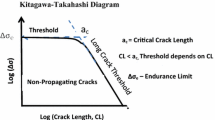Abstract
From previous observations of the surfaces of metals cycled in high strain fatigue, the mechanism of crack nucleation is considered a plastic instability phenomenon. A model for crack nucleation based on this conclusion is now developed quantitatively and a simple relationship between the number of cycles to nucleate a crack and the applied, plastic, strain range thus predicted. Since the model is valid for any material capable of plastic deformation, plasticine has been cycled in reversed bending to test its prediction. Cracks were observed to form in the plasticine by puckering of the surface at stress concentrations, in direct confirmation of the model. Moreover, the crack nucleation measurements on the plasticine and data on metals, taken from the literature, are considered to be in reasonable agreement with the prediction of the model.
Résumé
A partir d'observations précédentes faites sur la surface des métaux soumis à la fatigue oligocyclique, on a déduit que le mécanisme de formation de la fissure relevait d'un phénomène d'instabilité plastique.
Sur la base de cette conclusion, on développe à présent quantitativement un modèle de formation de la fissure, ce qui permet de prédire use relation simple entte le sombre de cycles nécessaires pour amorcer une fissure et l'écart de déformation plastique appliquée par cycle.
Le modèle étant appliquable à tout materiau susceptible de déformation plastiques, on a soumis à flexion alternée de la plasticise afin d'en vérifier les prédictions.
On a observé que, pour ce matériau, les fissures prenaient naissance par un processus de plissement de la surface aux endroits de concentration de tension, ce qui confirme directement le modèle proposé. En outre, les mesures de formation des fissures dans la plasticise ont été comparées aux données existantes dans la littérature, et qui se refèrent aux métaux.
Cette comparaison prêche en faveur d'une concommitence raisonnable des observations expérimentales et des prédictions du modèle.
Zusammenfassung
Ausgelrend von früheren Experimenten an Metalloberflächen, die starken Ermüdungs-verformungen unterworfen wurden, wird die Art der Rissentstehung als ein plastisches Instabilitätsphänomen betrachtet. Ein darauf aufbauendes Modell für die Rissentstehung wird quantitativ entwickelt and eine einfache Beziehung zwischen der Anzahl der zur Rissentstehung führenden Ermüdungsvorgänge and dem angewandten Verformungsbereich angegeben. Da das Modell auf jedes plastisch verformbare Material anwendbar ist, wurde seine Gültigkeit an Plastilin getestet, das periodischen Biegungen unterworfen wurde. Es wurden Risse im Plastilin beobachtet, die sich, entsprechend dem Modell, durch Faltenbildung der Oberfläche bei Stellen erhöhter Spannung ausbildeten. Ausserdern lässt sich feststellen, dass sowohl die Messergebnisse über Rissentstehung an Plastilin als auch die, der Literatur entnommenen, Messergebnisse an Metallen in brauchbarer Übereinstimmung mit den Aussagen des Modells stehen.
Similar content being viewed by others
References
N. Thompson and N.J. Wadsworth, Advances in Physics, 1958, 7, pp. 72–169.
D.H. Avery and W.A. Bockofen, Fracture of Solids, Edited by D.C. Drucker and J J. Gilman, J. Wiley and Sons, New York 1963, pp. 339–382.
C. Laird, “Influence of Metallurgical Structure on the Mechanism of Fatigue Crack Propagation’, A.S.T.M. 69th Annual Meeting, Atlantic City 1966. To be published in A.S.T.M. S.T.P. 415, 1967.
PJ.E. Forsyth, ‘A Two Stage Process of Fatigue Crack Growth’, Proc. of the Crack Propagation Symposium, Cranfield, 1961.
C. Laird and G.C. Smith, Phil. Mag., 1963, 8, pp. 1945–1963.
C. Laird and G.C. Smith, Phil. Mag., 1962, 7, pp. 847–857.
D.S. Kemsley, J. Inst. Metals, 1956, 85, pp. 420–422.
J. Porter and J.C. Levy, J. Inst. Metals, 1960, 89, pp. 86–89.
C. Laird, Ph. D. Thesis, Cambridge University, 1962.
R.C. Boettner, C. Laird and A.J. McEvily, Jr., Trans. A.I.M.E., 1963, 233, pp. 379–387.
C. Laird and C.E. Feltner, Trans. A.I.M.E., In press.
L.F. Coffin, Trans. A.I.M.E., 1960, 82D, pp. 671–682.
F.A. McClintock, Fracture of Solids, Edited by D.C. Drucker and J.J. Gilman, J. Wiley and Sons, New York 1963, pp. 65–102.
A.J. McEvily, Ford Motor Co., private communication.
H.W. Liu,Am. Soc. Mech. Engr., 1962, Paper No. 62-2.
J. Holden, Acta Met., 1963, 11, pp. 691–701.
J.E. Pratt, Acta Met., 1967, 15, pp. 319–327.
C.E. Feltner and C. Laird, Acta Met., In Press.
L.F. Coffin and J. Tavernelli, Gen. Elec. Research Lab., 1958, Report No. 58-RL-2100.
S.S. Manson, N.A.C.A., Tech. Note, 1953, T.N. 2933.
L. Northcott and H.G. Baron, J. Iron and Steel Inst., 1956, 184, pp. 385–408.
L.U. de Sitter, Structural Geology, McGraw-Hill Book Co., New York, 1956.
PJ.E. Forsyth and D.A. Ryder, Metallurgia, 1961, 63, pp. 117–124.
J. Weertman, Proc. of Intl. Conf. on Fracture, Sendai, Sept. 1965.
Author information
Authors and Affiliations
Rights and permissions
About this article
Cite this article
Laird, C., Krause, A.R. A theory of crack nucleation in high strain fatigue. Int J Fract 4, 219–231 (1968). https://doi.org/10.1007/BF00185258
Issue Date:
DOI: https://doi.org/10.1007/BF00185258




